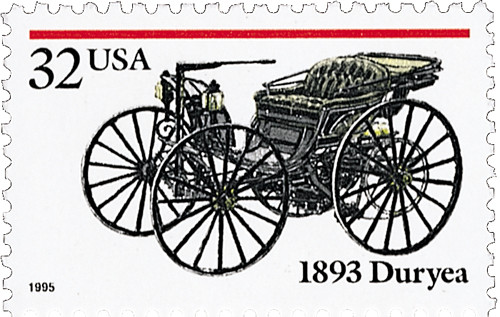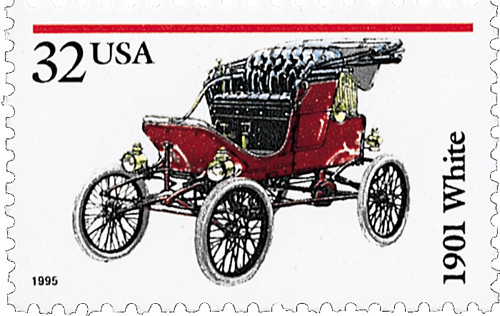
# 3019 - 1995 32c Antique Automobiles: 1893 Duryea
US #3019
1995 1893 Duryea
- Last stamps issued in 1995
- Set features 5 antique automobiles
Category of Stamp: Commemorative
Set: Antique Autos
Value: 32¢, First-Class mail rate
First Day of Issue: November 3, 1995
First Day City: New York, New York
Quantity Issued: 30,000,000
Printed by: J.W. Fergusson for Stamp Venturers
Printing Method: Photogravure
Format: Panes of 25 (from printing cylinders of 200 – 10 across, 20 down)
Perforations: 10.1 X 11.1
Reason the stamp was issued: This set of five stamps was issued to commemorate some of the first American automobiles. It follows the popular Classic Cars set (#2381-85).
About the stamp design: The stamps were created by the same artist, Ken Dallison, who was the talent behind the Classic Cars stamps. He specializes in painting cars, and his work has appeared in several publications. In addition to the Classic Cars set, Dallison also did the artwork for some of the stamps in the Transportation series and the Pioneers of Aviation airmail stamps.
First Day City: These stamps were dedicated on the second day of the American Stamp Dealers Association’s Postage Stamp Mega-Event. The event was sponsored by the American Philatelic Society and the US Postal Service. IT was held at the Jacob K. Javits Conventions Cetner in New York City. Ken Dallison, the stamps’ designer, was one of about 500 people who attended the ceremony.
History the stamp represents:
1893 Duryea: The Duryea brothers were two of America’s greatest automobile pioneers. Charles E. Duryea and J. Frank Duryea built the first successful gasoline-powered car in the United States. This prototype car was a powered horse buggy, with a single-cylinder four horsepower engine and friction drive. Frank Duryea built a second car, and with it, took first place in America’s first automobile race – the Chicago Times Herald race, which was held on Thanksgiving Day. Only one other car finished the 50-mile race. The Duryea brothers collected the first-place prize of $2,000 for their speedy performance – their car averaged 7 miles per hour!
In 1895 the brothers formed the Springfield, Massachusetts-based Duryea Motor Wagon Company. Thirteen cars were produced by this enterprise in 1896. Frank Duryea left the company and joined Stevens Arms Company in 1898. There he designed four-cylinder and six-cylinder Stevens-Duryea automobiles.
Charles Duryea went on to form three other successful commercial automobile interests: Duryea Mfg. Co., based in Peoria, Illinois (1896-1898); Duryea Power Co., located in Reading, Pennsylvania (1899-1908); and Duryea Motor Co., based in Saginaw, Michigan (1908-1913).
US #3019
1995 1893 Duryea
- Last stamps issued in 1995
- Set features 5 antique automobiles
Category of Stamp: Commemorative
Set: Antique Autos
Value: 32¢, First-Class mail rate
First Day of Issue: November 3, 1995
First Day City: New York, New York
Quantity Issued: 30,000,000
Printed by: J.W. Fergusson for Stamp Venturers
Printing Method: Photogravure
Format: Panes of 25 (from printing cylinders of 200 – 10 across, 20 down)
Perforations: 10.1 X 11.1
Reason the stamp was issued: This set of five stamps was issued to commemorate some of the first American automobiles. It follows the popular Classic Cars set (#2381-85).
About the stamp design: The stamps were created by the same artist, Ken Dallison, who was the talent behind the Classic Cars stamps. He specializes in painting cars, and his work has appeared in several publications. In addition to the Classic Cars set, Dallison also did the artwork for some of the stamps in the Transportation series and the Pioneers of Aviation airmail stamps.
First Day City: These stamps were dedicated on the second day of the American Stamp Dealers Association’s Postage Stamp Mega-Event. The event was sponsored by the American Philatelic Society and the US Postal Service. IT was held at the Jacob K. Javits Conventions Cetner in New York City. Ken Dallison, the stamps’ designer, was one of about 500 people who attended the ceremony.
History the stamp represents:
1893 Duryea: The Duryea brothers were two of America’s greatest automobile pioneers. Charles E. Duryea and J. Frank Duryea built the first successful gasoline-powered car in the United States. This prototype car was a powered horse buggy, with a single-cylinder four horsepower engine and friction drive. Frank Duryea built a second car, and with it, took first place in America’s first automobile race – the Chicago Times Herald race, which was held on Thanksgiving Day. Only one other car finished the 50-mile race. The Duryea brothers collected the first-place prize of $2,000 for their speedy performance – their car averaged 7 miles per hour!
In 1895 the brothers formed the Springfield, Massachusetts-based Duryea Motor Wagon Company. Thirteen cars were produced by this enterprise in 1896. Frank Duryea left the company and joined Stevens Arms Company in 1898. There he designed four-cylinder and six-cylinder Stevens-Duryea automobiles.
Charles Duryea went on to form three other successful commercial automobile interests: Duryea Mfg. Co., based in Peoria, Illinois (1896-1898); Duryea Power Co., located in Reading, Pennsylvania (1899-1908); and Duryea Motor Co., based in Saginaw, Michigan (1908-1913).













